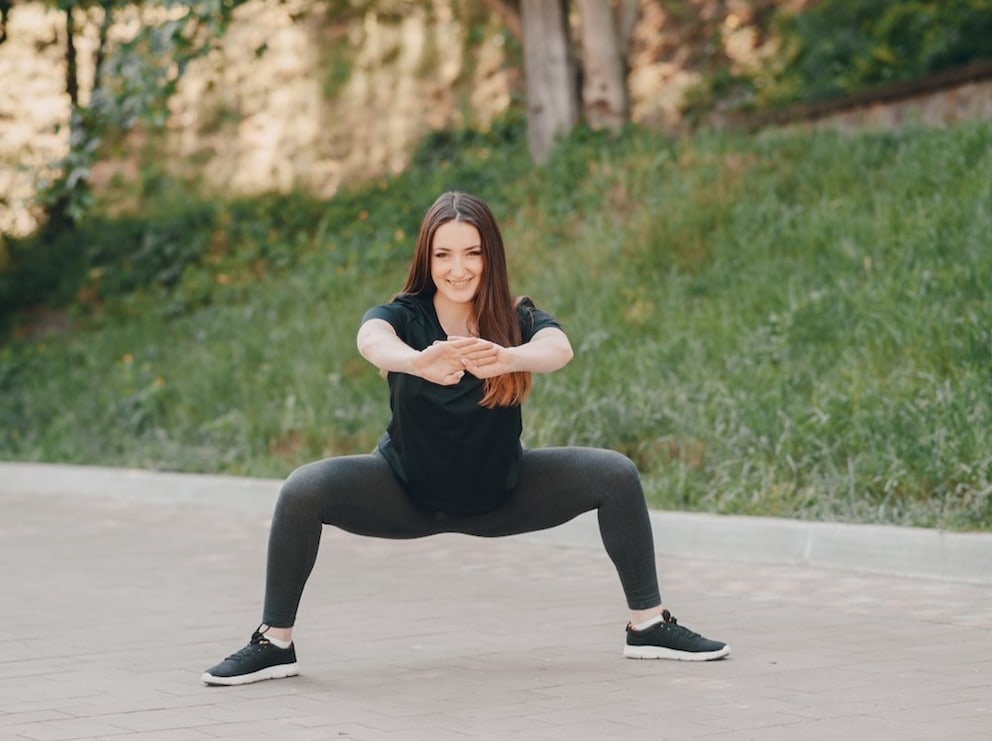July 18, 2025, 2:30 am | Read time: 5 minutes
Squats are a classic in strength training. Without much equipment, they effectively train legs and glutes. They can be easily varied, allowing you to target different muscles and add new energy to your routine. Here, we present seven squat variations you can try at the gym or at home. As always, pay attention to proper form!
Squats pack a punch. They simultaneously work the glutes and thighs, and also engage the abdominal and back muscles—four major muscle groups. This not only helps build muscle but also boosts calorie burn. Even classic squats can make you sweat, but there are variations that take the exercise to a whole new level, including the Pistol Squat and the Bulgarian Split Squat.
Classic Squats
In the starting position, place your feet slightly wider than shoulder-width apart, with toes turned slightly outward (about 10 to 20 degrees).
For the downward movement, push your hips back and lower your torso slowly into the squat from the hips. Ensure your body weight shifts to the middle to rear part of your feet. With good mobility, the squat is most effective when you go down far enough for your hips to be below your knees. If your hips aren’t flexible enough to maintain a straight back in this position, stop higher up.
Avoid Common Mistakes
Squats look simple but are technically demanding. Avoid these common mistakes:
- rounded back
- incorrect foot position
- knees buckling inward
- incorrect head position
Poor posture can not only make training ineffective but also cause long-term damage, such as to muscles, tendons, or joints. Learn more about possible squat mistakes and how to avoid them here.
Already mastered classic squats? Add variety and new challenges to your training by trying one or more of the following variations.
Also interesting: Are squats harmful to the joints?
Back Squats

Besides squats without equipment, the barbell variant is likely one that most have tried or at least seen others do at the gym.
In this exercise, you place a barbell on your shoulders and perform squats. The added weight means your core muscles work significantly harder than in classic squats. You need to tense your abdominal and back muscles well to perform squats with the barbell correctly. Thus, the exercise also becomes a good core workout. The thigh and glute muscles are more engaged, leading to higher calorie burn—depending on the weight used—than many other strength exercises.
Also interesting: 3 muscle-building techniques from “The Rock” for his “Black Adam” transformation
Landmine Squats
This squat variant is very effective for strengthening the glutes, legs, and lower back. The barbell is also used in this squat variant. These squats, also called Lumberjack Squats, get their name from the barbell, which is anchored to the ground with a “landmine” device. Learn what to watch out for during the exercise here.
Landmine Squats are ideal for training the quadriceps, gluteus maximus, and lower back (erector spinae). They also benefit the calves (gastrocnemius and soleus), shoulders (deltoideus), and biceps.
Goblet Squat
This squat variant is performed with a weight (dumbbell or kettlebell) held in front of the torso. The Goblet Squat engages the thighs, glutes, calves, arms, and shoulders. The core and back muscles also benefit from this form of squat. Learn how to perform Goblet Squats correctly here.
Also interesting: 7 foods that are bad for muscle building
Pistol Squats
Pistol Squats are a challenging bodyweight exercise performed without additional weight. They offer a new challenge for squat pros who no longer find the traditional variant difficult. Pistol Squats are performed on one leg. For proper technique, keep the ball of your foot on the ground and your back straight. Preliminary exercises, such as mobilizing the ankle and hip, help you approach these demanding one-legged squats. Learn which exercises to do for this purpose here.
Bulgarian Split Squats
Bulgarian Split Squats are also performed on one leg, with the rear leg elevated. You can rest it on a training bench, for example. Place the front leg about a meter in front of the bench and lower your body. Holding a dumbbell in each hand makes the exercise even more challenging. Learn which mistakes to avoid to get the most out of this squat variant and explore more variations of Bulgarian Split Squats here.

Goodbye, Flabby Arms! 3 Simple Exercises for Defined Upper Arms

7 Effective Exercises for the Glute Muscles

How to Get Your Bike Ready for Summer
Sumo Squats

Sumo Squats are a wide-legged variant of classic squats that particularly target the glutes and inner thighs. They are performed with legs spread wide, similar to sumo wrestlers in the ring. Ensure your knees don’t buckle inward. If this happens, bring your legs closer together or don’t squat as deep. Feet should point slightly outward. If you master the correct form and want more of a challenge, hold a weight in your hands in front of your body or perform a wide-legged variant of the Back Squat.



